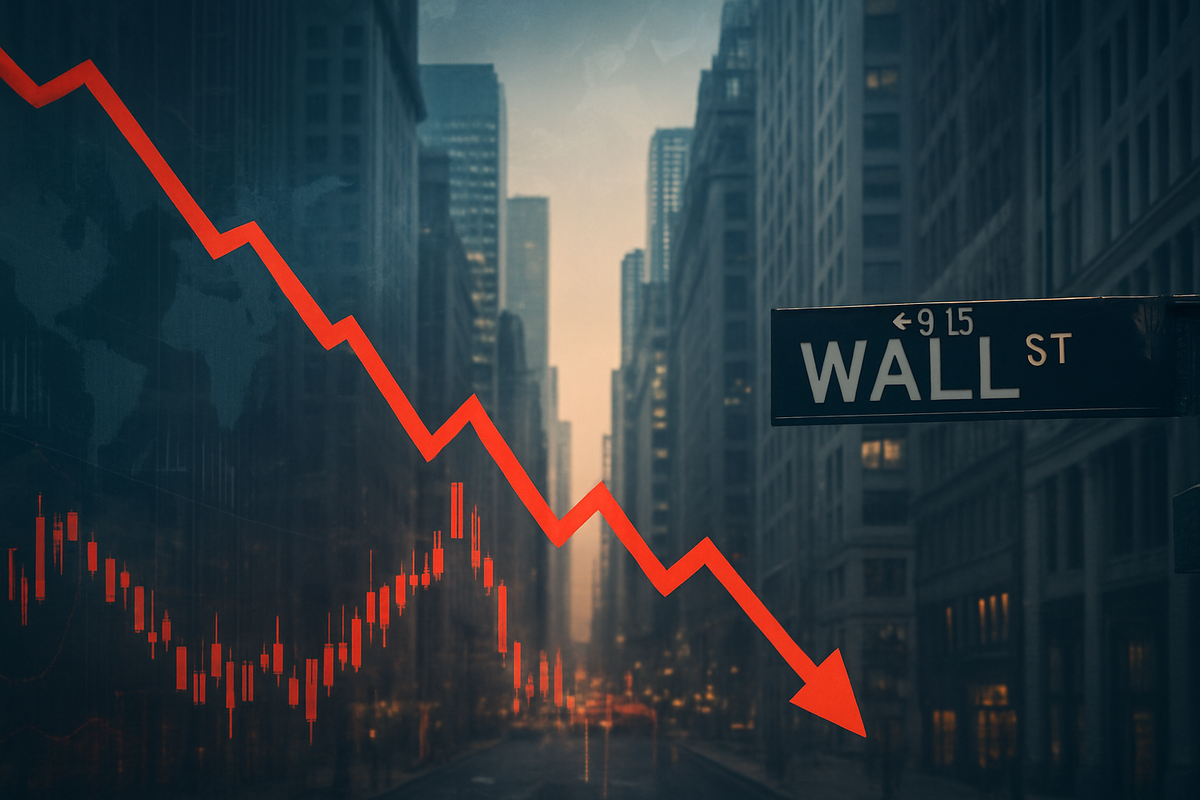
As the clock ticked past the opening bell on October 30, 2025, Wall Street found itself navigating a familiar, yet unsettling, landscape: an early trading dip. Investors are keenly watching as major indices show signs of weakness, signaling a cautious mood permeating the financial markets. This downturn appears to be a confluence of several potent factors, ranging from recent economic data releases to lingering geopolitical anxieties and a watchful eye on corporate performance. The immediate implication is heightened volatility and a re-evaluation of risk appetite, as market participants grapple with an evolving economic narrative.
The Undercurrents: Specific Triggers for Today's Market Retreat
The early market retreat on Wall Street today can be attributed to a combination of intertwined factors, each contributing to a collective sense of unease. One significant hypothetical trigger could be the release of unexpectedly high inflation data. Imagine if, just yesterday, the Bureau of Labor Statistics unveiled the Consumer Price Index (CPI) for September 2025, revealing a re-acceleration of inflation, potentially pushing annualized rates above 4% or 5%. Such a report would immediately rekindle fears of a more aggressive or prolonged hawkish stance from the Federal Reserve, impacting borrowing costs and corporate profitability.
Compounding these concerns, hypothetical weak employment or manufacturing data could also be playing a role. A scenario where the September Non-Farm Payrolls report showed unexpectedly negative job growth, or the October Manufacturing PMI dropped significantly into contractionary territory (below 50), would signal a weakening economy and heighten recessionary fears. Both reduced consumer demand and decreased industrial activity would naturally weigh on corporate revenues and earnings, prompting investors to shed riskier assets.
Beyond economic indicators, geopolitical tensions always loom large. A hypothetical escalation of a major geopolitical conflict overnight, perhaps a military incident in a critical shipping lane or a cyber-attack on a major economy's infrastructure, would undoubtedly trigger immediate risk aversion. Such events can spike energy prices, disrupt supply chains, and send investors scrambling for safe-haven assets, leading to a broad sell-off in equities. Furthermore, a wave of disappointing corporate earnings reports, particularly from bellwether technology companies, could be adding to the market's woes. If several major tech players (e.g., Apple (NASDAQ: AAPL), Microsoft (NASDAQ: MSFT), Amazon (NASDAQ: AMZN)) reported weaker-than-expected Q3 2025 earnings or issued significantly lower forward guidance, it would signal a broader deterioration in corporate health, dragging down the wider market.
Corporate Fortunes: Winners and Losers in a Volatile Market
In an environment marked by an early market dip, the fortunes of public companies often diverge sharply. Companies highly sensitive to interest rates, particularly growth stocks in the technology sector, tend to be among the biggest losers. When inflation fears drive expectations of higher interest rates, the present value of their future earnings decreases, making them less attractive to investors. Tech giants like Alphabet (NASDAQ: GOOGL), Meta Platforms (NASDAQ: META), and Nvidia (NASDAQ: NVDA), which often trade at higher valuations based on future growth potential, could see significant pressure.
Conversely, companies with strong balance sheets, stable cash flows, and those in defensive sectors like utilities (e.g., NextEra Energy (NYSE: NEE)) or consumer staples (e.g., Procter & Gamble (NYSE: PG)) might fare relatively better, as investors seek safety. However, a broader market dip can still exert downward pressure across the board. Companies with significant international trade exposure could also suffer if geopolitical tensions lead to new tariffs or supply chain disruptions. For example, multinational manufacturers or retailers reliant on global supply chains could see their profit margins squeezed. Financial institutions, such as JPMorgan Chase (NYSE: JPM) or Bank of America (NYSE: BAC), could face mixed impacts; while higher rates might initially boost net interest margins, increased loan loss provisions due to an economic slowdown or higher default rates could offset these gains. Ultimately, companies demonstrating resilience in their earnings, prudent cost management, and clear forward guidance will be best positioned to weather the storm, while those with speculative business models or high debt loads may find themselves under severe scrutiny.
Broader Implications: Navigating the Macroeconomic Landscape
The early dip on Wall Street, potentially driven by persistent inflation concerns and a hawkish central bank outlook, fits squarely into broader industry trends that have dominated financial discourse for the past few years. The struggle against sticky inflation and the subsequent tightening monetary policies by central banks globally remain central themes. This market reaction underscores the ongoing sensitivity to any data suggesting that inflation is not fully tamed, or that interest rates will remain higher for longer than anticipated.
The potential ripple effects are extensive. On competitors and partners, a general market downturn can lead to reduced consumer and business spending, impacting revenues across various sectors. Companies might scale back investment plans, affecting suppliers and delaying innovation. Furthermore, geopolitical events, if they are indeed a contributing factor, can trigger a re-evaluation of global supply chains, potentially accelerating trends towards reshoring or nearshoring for critical components, which could benefit domestic manufacturers but raise costs. Regulatory or policy implications could emerge if economic weakness persists. Governments might face pressure to introduce fiscal stimulus measures, while central banks could eventually pivot their monetary policy stance if recessionary risks become too high. Historically, periods of high inflation followed by aggressive rate hikes have often led to economic slowdowns or recessions, making comparisons to similar events in the 1970s and early 1980s relevant, though the current economic structure and global interconnectedness present unique challenges.
What Comes Next: Navigating the Path Ahead
Looking ahead, the immediate future for Wall Street is likely to be characterized by continued volatility. Short-term possibilities include further market corrections if subsequent economic data or corporate earnings reports confirm the current negative sentiment. Investors will be closely watching upcoming speeches from Federal Reserve officials and the minutes from their recent meetings for any clues regarding future monetary policy. A sustained period of higher interest rates could force companies to undertake significant strategic pivots, focusing more on cost efficiency, debt reduction, and resilient supply chains rather than aggressive growth.
In the long term, these dynamics could lead to a re-pricing of assets across the board. Market opportunities may emerge for value investors seeking to capitalize on oversold stocks with strong fundamentals. Conversely, challenges will persist for highly leveraged companies or those reliant on easy access to cheap capital. Potential scenarios range from a "soft landing" where inflation gradually subsides without a severe recession, to a more challenging "hard landing" involving a significant economic downturn. Companies may need to adapt by diversifying revenue streams, hedging against geopolitical risks, and optimizing operational efficiencies to navigate this uncertain landscape. The ability to innovate and maintain financial discipline will be paramount for survival and growth.
Comprehensive Wrap-Up: Key Takeaways and Investor Outlook
Today's early dip on Wall Street serves as a stark reminder of the fragility of market sentiment in the face of persistent economic and geopolitical uncertainties. The key takeaways are clear: inflation remains a formidable opponent, central bank policies are pivotal, and geopolitical stability is a non-negotiable prerequisite for sustained market health. The market is moving forward with a heightened sense of caution, where every piece of economic data and every corporate announcement is scrutinized for signs of a broader trend.
For investors, the coming months will demand vigilance and strategic patience. It is crucial to watch for continued inflation trends, paying close attention to both headline and core CPI figures. The Federal Reserve's rhetoric and actions, particularly regarding future interest rate adjustments, will be paramount. Additionally, the geopolitical landscape, especially developments in critical regions, could rapidly shift market dynamics. Investors should focus on companies with robust balance sheets, strong competitive advantages, and a proven ability to generate free cash flow. Diversification across sectors and asset classes remains a prudent strategy to mitigate risks in this evolving and often unpredictable market environment.
This content is intended for informational purposes only and is not financial advice







